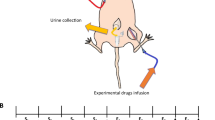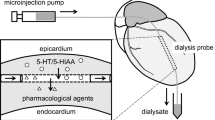Abstract
1,1′-Diisopropyl-2,4′-cyanine (disprocynium24), a potent inhibitor of the extraneuronal monoamine transport system (uptake2), was previously shown to reduce the clearance of catecholamines from plasma not only by blocking uptake2 but presumably also by blocking organic cation transport. To provide more direct evidence for the latter conclusion, the present study was carried out in anaesthetized rabbits. It aimed at determining the effect of disprocynium24 on the renal excretion of catecholamines which is known to be, at least in part, a consequence of organic cation transport in the kidney. To this end, the plasma clearance due to renal excretion (Clu) of endogenous as well as infused 3H-labelled adrenaline, noradrenaline and dopamine was determined for 60-min periods of urine collection in rabbits treated either with disprocynium24 (270 nmol kg-1 i.v followed by i.v. infusion of 80 nmol kg-1 min-1) or vehicle. Two groups of animals were studied: group I (monoamine oxidase and catechol-O-methyltransferase intact) and group II (monoamine oxidase and catechol-O-methyltransferase inhibited). A third group of animals with intact monoamine oxidase and catechol-O-methyltransferase was used to study the effect of disprocynium24 on the glomerular filtration rate (as determined by measuring the plasma clearance of inulin). In vehicle controls, Clu of endogenous adrenaline, noradrenaline and dopamine was 7.2, 5.2 and 153.6 ml kg-1 min-1, respectively, in group I and 10.4, 7.0 and 134.3 ml kg-1 min-1, respectively, in group II. Similar control values of Clu were obtained for infused 3H-adrenaline and 3H-noradrenaline, but not for infused 3H-dopamine; Clu of 3H-dopamine (4.9 ml kg-1 min-1 in group I and 15.4 ml kg-1 min-1 in group II) was considerably smaller than Clu of endogenous dopamine, indicating that most of the dopamine in urine (i.e., 98% in group I and 92% in group II) was derived from the kidneys rather than from the circulation. By contrast, only about one quarter of the noradrenaline in urine (32% in group I and 24% in group II) and none of the urinary adrenaline were of renal origin. In both groups, disprocynium24 markedly reduced the Clu of endogenous catecholamines (by 72-90%) and of infused 3H-catecholamines (by 49-69%). Moreover, it preferentially inhibited the renal excretion of those components of urinary dopamine and noradrenaline which were derived from the kidney. Therefore, disprocynium24 inhibits the tubular secretion of catecholamines and, hence, organic cation transport in the kidney. This conclusion was substantiated by the observation that disprocynium24 did not alter the glomerular filtration rate.
Similar content being viewed by others
Author information
Authors and Affiliations
Additional information
Received: 6 February 1997 / Accepted: 12 April 1997
Rights and permissions
About this article
Cite this article
Graefe, KH., Friedgen, B., Wölfel, R. et al. 1,1′-Diisopropyl-2,4′-cyanine (disprocynium24), a potent uptake2 blocker, inhibits the renal excretion of catecholamines. Naunyn-Schmiedeberg's Arch Pharmacol 356, 115–125 (1997). https://doi.org/10.1007/PL00005018
Issue Date:
DOI: https://doi.org/10.1007/PL00005018




